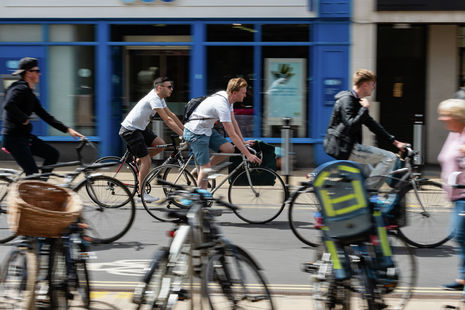No need to reinvent the wheel
The physics behind a bicycle, and how it explains hurricanes and cats

My bike key once snapped inside of my D-lock, leaving my bike stuck outside Boots. As a Hill college student, I was filled with dread at the thought of the half-hour walk down to Downing site the next morning (until an Emmanuel College porter found me crying on the phone to my father and sawed the lock off for me – lifesaver). With the vast majority of us cycling around Cambridge, it’s an essential part of the student experience here. But have you ever stopped to understand how a bicycle works, and appreciate the physics behind this seemingly humble two-wheeled creation?
“The faster your wheels go, the stronger the restoring force keeping you upright”
The mechanics of it are pretty simple. You pedal, it turns the cogs at your feet, they pull the chain which turns the back wheel, and off you go. Changing gears changes the size of the cog; the smaller the cog the more revolutions of the back wheel you get per pedal-revolution. As with most wheeled-vehicles, an input makes the wheels go round and friction between the tyres and the road surface allows forward motion.
Where a bike differs from a four-wheel car is the need for balance. There is a reason that stationary, a bike will fall over, but not whilst it is moving. Although down to a combination of factors such as steering adjustments and the centre of mass of the cyclist, the key explanation lies with a common quantity in physics: angular momentum. In the same way that typical momentum means objects like to stay as they are (note Newton’s first law of motion: an object remains at constant motion unless acted upon by a resultant force), angular momentum means a spinning wheel likes to stay spinning around the same axis. This is known as the gyroscopic effect and stops you from falling off your bike by providing balance. The faster your wheels go, the stronger the restoring force keeping you upright.
“A classic O*ford physics interview question asked students what way a hurricane spins. It’s not a trick question”
A bike is not the only everyday scenario explained by angular momentum – it crops up in all sorts of interesting stories, particularly through the conservation of it: an object not rotating cannot just start to rotate.
The concept of cats landing on four feet puzzled physicists for years because it seemed to violate the conservation of angular momentum. It was in the 1960s that NASA realised if you model a cat as two cylinders, one for the back and one for the front (an average physics assumption), that when the cat goes from a ‘u’ to an ‘n’ the two cylinders must have rotated in opposite orientations, thus conserving angular momentum and the problem was solved.
A classic O*ford physics interview question asked students what way a hurricane spins. It’s not a trick question – they spin anticlockwise in the northern hemisphere, and clockwise in the southern. This is because the earth spins faster at the equator, so wind travelling towards the poles will ‘bend’ east to conserve their angular momentum, leading to storms forming in the given patterns.
So, the next time you cycle uphill, you’ll understand why you have to keep both hands planted firmly on the handlebars – the wheels aren’t going round fast enough to provide enough of a restoring force, so you instinctively rely more on steering adjustments to prevent a face full of tarmac. And, regardless of speed, wear your helmet!
 Features / Should I stay or should I go? Cambridge students and alumni reflect on how their memories stay with them15 December 2025
Features / Should I stay or should I go? Cambridge students and alumni reflect on how their memories stay with them15 December 2025 News / Cambridge study finds students learn better with notes than AI13 December 2025
News / Cambridge study finds students learn better with notes than AI13 December 2025 Comment / The magic of an eight-week term15 December 2025
Comment / The magic of an eight-week term15 December 2025 News / News In Brief: Michaelmas marriages, monogamous mammals, and messaging manipulation15 December 2025
News / News In Brief: Michaelmas marriages, monogamous mammals, and messaging manipulation15 December 2025 News / Uni Scout and Guide Club affirms trans inclusion 12 December 2025
News / Uni Scout and Guide Club affirms trans inclusion 12 December 2025










